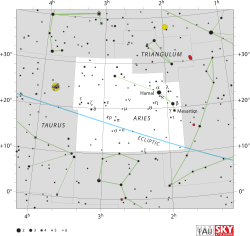Rho2 Arietis
From Wikipedia, the free encyclopedia
- For other star systems with this Bayer designation, see Rho Arietis.

Location of ρ2 Arietis (circled) | |
| Observation data Epoch J2000.0 Equinox J2000.0 (ICRS) | |
|---|---|
| Constellation | Aries |
| Right ascension | 02h 55m 48.49800s[1] |
| Declination | +18° 19′ 53.9029″[1] |
| Apparent magnitude (V) | 5.93[2] (5.62–6.01)[3] |
| Characteristics | |
| Spectral type | M6 III[4] |
| U−B color index | +1.12[2] |
| B−V color index | +1.51[2] |
| R−I color index | 2.17[5] |
| Variable type | SRB[3] |
| Astrometry | |
| Radial velocity (Rv) | +46.0[6] km/s |
| Proper motion (μ) | RA: −7.78[1] mas/yr Dec.: −14.98[1] mas/yr |
| Parallax (π) | 9.28 ± 0.30[1] mas |
| Distance | 350 ± 10 ly (108 ± 3 pc) |
| Details | |
| Surface gravity (log g) | 0.30[7] cgs |
| Temperature | 3,250[7] K |
| Metallicity [Fe/H] | –0.24[7] dex |
| Other designations | |
Rho2 Arietis is the Bayer designation for a M-type red giant star in the northern constellation of Aries. With an annual parallax shift of 9.28 mas,[1] it is approximately 350 light-years (110 parsecs) distant from the Earth. It is classified as a semiregular variable star with periods of 49.9 and 54.8 days,[9] while varying in visual magnitude between 5.62 and 6.01. This star is also known by its variable star designation, RZ Arietis.[3]
References
- ↑ 1.0 1.1 1.2 1.3 1.4 1.5 van Leeuwen, F. (November 2007), "Validation of the new Hipparcos reduction", Astronomy and Astrophysics 474 (2): 653–664, arXiv:0708.1752, Bibcode:2007A&A...474..653V, doi:10.1051/0004-6361:20078357.
- ↑ 2.0 2.1 2.2 Lee, T. A. (October 1970), "Photometry of high-luminosity M-type stars", Astrophysical Journal 162: 217, Bibcode:1970ApJ...162..217L, doi:10.1086/150648.
- ↑ 3.0 3.1 3.2 V* RZ Ari, entry, Combined General Catalog of Variable Stars (GCVS4.2, 2004 Ed.), N. N. Samus, O. V. Durlevich, et al., CDS ID II/250.
- ↑ Morgan, W. W.; Keenan, P. C. (1973), "Spectral Classification", Annual Review of Astronomy and Astrophysics 11: 29, Bibcode:1973ARA&A..11...29M, doi:10.1146/annurev.aa.11.090173.000333.
- ↑ HR 867, entry, Bright Star Catalogue, 5th Revised Ed., D. Hoffleit and W. H. Warren, Jr., 1991, CDS ID V/50.
- ↑ Famaey, B. et al. (January 2005), "Local kinematics of K and M giants from CORAVEL/Hipparcos/Tycho-2 data. Revisiting the concept of superclusters", Astronomy and Astrophysics 430 (1): 165–186, arXiv:astro-ph/0409579, Bibcode:2005A&A...430..165F, doi:10.1051/0004-6361:20041272.
- ↑ 7.0 7.1 7.2 Prugniel, Ph.; Vauglin, I.; Koleva, M. (July 2011), "The atmospheric parameters and spectral interpolator for the MILES stars", Astronomy & Astrophysics 531: A165, arXiv:1104.4952, Bibcode:2011A&A...531A.165P, doi:10.1051/0004-6361/201116769.
- ↑ "RZ Ari -- Semi-regular pulsating Star", SIMBAD Astronomical Database (Centre de Données astronomiques de Strasbourg), retrieved 2012-08-08.
- ↑ Tabur, V. et al. (December 2009), "Long-term photometry and periods for 261 nearby pulsating M giants", Monthly Notices of the Royal Astronomical Society 400 (4): 1945–1961, arXiv:0908.3228, Bibcode:2009MNRAS.400.1945T, doi:10.1111/j.1365-2966.2009.15588.x.
Coordinates: ![]() 02h 55m 48.4978s, +18° 19′ 53.903″
02h 55m 48.4978s, +18° 19′ 53.903″
| ||||||||||||||||||||||||||
This article is issued from Wikipedia. The text is available under the Creative Commons Attribution/Share Alike; additional terms may apply for the media files.